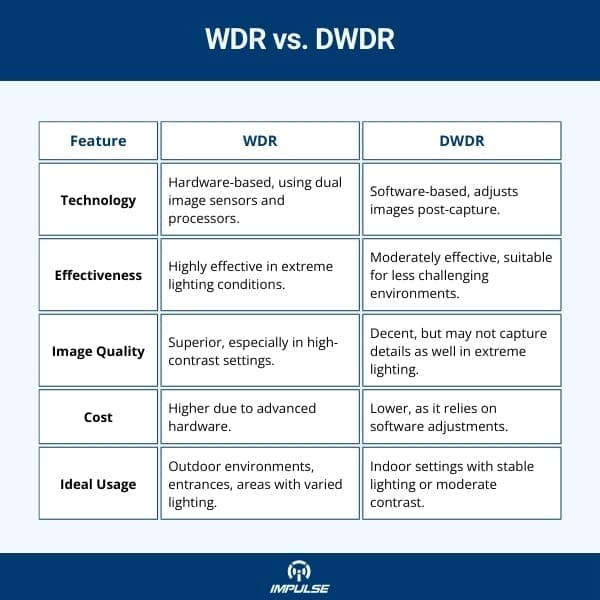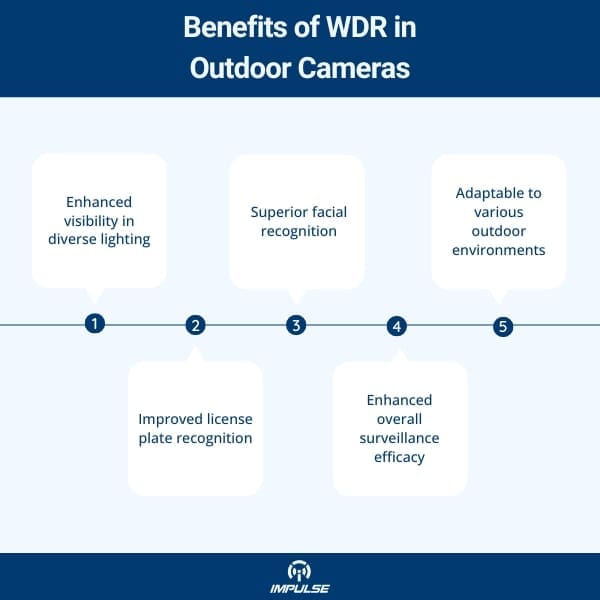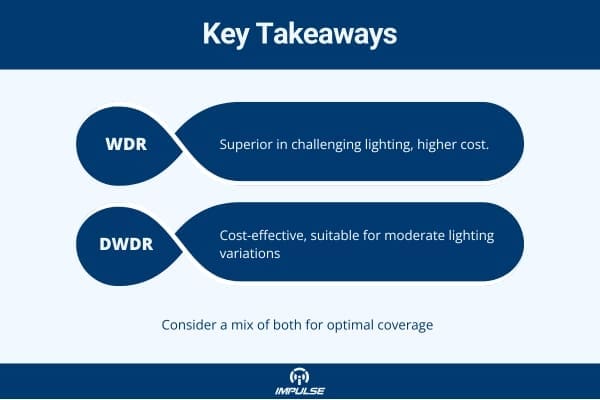Security cameras are critical for safeguarding spaces, and their effectiveness hinges on capturing clear footage in various lighting conditions. Two technologies often discussed when addressing lighting challenges are WDR (Wide Dynamic Range) and DWDR (Digital Wide Dynamic Range). Understanding the differences between these technologies can help in selecting the best CCTV camera for outdoor use in India. In this blog, we will explore WDR vs. DWDR, the key differences between them, and how they enhance security camera performance.
What is Wide Dynamic Range (WDR)?
Wide Dynamic Range (WDR) is a technology used in security cameras to provide clear images in environments with high contrast lighting. In simpler terms, it allows the camera to balance both very bright and very dark areas in the same frame, ensuring all details are visible. This is crucial in settings where harsh lighting or backlighting may obscure important details, such as in areas with large windows, entrances, or parking lots.
WDR works by capturing multiple images of the same scene at different exposure levels and then combining them to create a single, balanced image. The resulting image will have visible details in both the lightest and darkest areas.
Key Applications of WDR in Security Cameras:
- Parking lots: Balancing the brightness of headlights with the dark surroundings.
- Building entrances: Managing bright sunlight while capturing details in shaded areas.
- Indoor spaces with windows: Balancing outdoor sunlight with indoor lighting.
- Retail stores: Handling glare from reflective surfaces while maintaining visibility in darker corners.
- Outdoor ATMs: Ensuring clear images of users’ faces despite varying light conditions throughout the day.
- Warehouses: Capturing details in both well-lit and shadowy areas for inventory management and security.

What is Digital Wide Dynamic Range (DWDR)?
Digital Wide Dynamic Range (DWDR) is a software-based version of WDR technology. Unlike WDR, which adjusts exposure during the capture process, DWDR manipulates the image digitally after it’s captured to balance brightness and contrast. This method is less effective than hardware-based WDR, but it can still enhance image quality, especially in lower-end cameras where hardware-based WDR is not available.
While DWDR vs. WDR both aim to improve image clarity in varying lighting conditions, DWDR may struggle in extreme high-contrast environments compared to true WDR. However, DWDR is useful for budget-conscious solutions and environments with less severe lighting challenges.
Key Applications of DWDR:
- Indoor spaces with artificial lighting and minimal natural light.
- Budget-friendly security installations where advanced WDR may not be necessary.
- Small retail stores with consistent lighting conditions.
- Residential settings where extreme light variations are uncommon.
- Office environments with controlled lighting scenarios.
- Indoor corridors or hallways with minimal exposure to outdoor light.
Differences Between WDR and DWDR
Understanding the differences between WDR and DWDR is crucial for selecting the most suitable security camera for specific applications. Let’s delve into a comprehensive breakdown of the key differences between WDR and DWDR:
1. Technology Implementation
WDR (Wide Dynamic Range): This is a hardware-based solution that utilizes specialized image sensors and processors. WDR cameras capture multiple exposures of the same scene and combine them to create a balanced image.
DWDR (Digital Wide Dynamic Range): This is a software-based approach that uses digital signal processing to enhance image quality after capture. It doesn’t require specialized hardware, making it a more cost-effective option.
2. Performance in Extreme Lighting Conditions
WDR: Excels in high-contrast environments, capable of handling scenes with both very bright and very dark areas simultaneously. It can typically manage a dynamic range of up to 120 dB or more.
DWDR: While it improves image quality in varying light conditions, it may struggle in extreme high-contrast scenarios. Its effectiveness is generally limited to a narrower dynamic range compared to true WDR.
3. Image Quality and Detail Retention
WDR: Provides superior image quality, preserving details in both highlights and shadows. This is particularly beneficial for facial recognition and license plate reading in challenging lighting conditions.
DWDR: Offers improved image quality compared to standard cameras, but may not retain as much detail in extreme lighting situations. It’s often sufficient for general surveillance in moderately challenging lighting environments.

4. Cost Implications
WDR: Generally more expensive due to the specialized hardware required. The higher cost is often justified in high-security applications or areas with consistently challenging lighting conditions.
DWDR: More affordable as it relies on software processing rather than specialized hardware. This makes it an attractive option for budget-conscious installations or areas with less demanding lighting conditions.
5. Ideal Usage Scenarios
WDR: Best suited for outdoor environments, building entrances, areas with large windows, and any location where there’s a significant variation in lighting throughout the day. It’s crucial for high-security applications like banks, airports, and government facilities.
DWDR: Well-suited for indoor settings with more controlled lighting, such as office spaces, retail stores, and residential areas. It’s also a good choice for locations where lighting conditions are relatively consistent or only moderately challenging.
6. Power Consumption and Heat Generation
WDR: May consume more power due to the additional hardware processing, potentially generating more heat. This could be a consideration in environments where power efficiency is crucial.
DWDR: Generally more power-efficient as it relies on software processing, which typically consumes less energy and generates less heat.
Also read: Futureproof Your Business: A Smart Guide to Choosing Video Surveillance for Tomorrow
The Role of WDR in Outdoor Surveillance
When it comes to outdoor surveillance, WDR is often a must-have feature. Cameras placed in outdoor locations, such as parking lots, building exteriors, or street corners, frequently face high-contrast lighting situations. Without WDR, a camera may either overexpose the bright areas or underexpose the darker areas, rendering the footage less useful.
Benefits of WDR in Outdoor Cameras:
WDR: Capturing clear details in challenging outdoor lighting conditions, from bright sunlight to deep shadows!

- Enhanced visibility across diverse lighting conditions: WDR technology ensures that crucial details remain visible in both extremely bright and dark areas of the frame, effectively combating issues like glare from sunlight or deep shadows cast by buildings.
- Superior facial recognition capabilities: By balancing exposure levels, WDR significantly improves the camera’s ability to capture clear facial features, whether in the harsh midday sun or during low-light evening hours, aiding in accurate identification for security purposes.
- Adaptability to various outdoor environments: WDR-equipped cameras offer unparalleled flexibility in placement, performing consistently well in a wide array of outdoor settings, from open parking lots to partially shaded entryways, without compromising image quality due to lighting inconsistencies.
- Improved license plate recognition: In scenarios involving moving vehicles, WDR technology helps capture clear, legible license plate images, even when dealing with reflective surfaces or stark contrasts between sunlit and shaded areas.
- Enhanced overall surveillance efficacy: By providing clear, balanced footage throughout the day and night, WDR significantly boosts the effectiveness of outdoor security systems, ensuring that no critical details are lost due to challenging lighting conditions.
Also Read: Top 5 Outdoor Network Cameras for Businesses: Deter Crime and Monitor Property
DWDR: The Budget-Friendly Alternative
While WDR offers superior performance, DWDR remains a viable option for certain installations. For small indoor spaces where lighting is more controlled, DWDR can provide sufficient enhancement to improve image clarity without the need for costly hardware.
Common Applications of DWDR in Security Camera Systems:
- Office Environments: DWDR excels in spaces with controlled artificial lighting, where extreme brightness variations are less common. It effectively balances light levels in conference rooms, cubicles, and corridors, ensuring clear visibility without the need for more advanced WDR technology.
- Retail Establishments: In stores where lighting conditions are generally uniform, DWDR proves highly effective. It can adeptly handle minor lighting challenges such as reflections from display cases or shadows in corners, providing clear footage for both security and customer service purposes.
- Cost-Effective Home Security: For homeowners seeking to enhance their property’s security without investing in high-end equipment, DWDR offers an excellent middle ground. It provides improved image quality in typical residential settings, such as entryways, living areas, and garages, where lighting conditions may vary but rarely reach extreme contrasts.
- Small Business Premises: DWDR is ideal for small businesses operating in indoor spaces with consistent lighting. It can effectively monitor customer areas, stockrooms, and cash registers, providing clear footage without the added expense of full WDR capabilities.
While DWDR vs. WDR may not be as robust, it still provides an upgrade over cameras without any dynamic range enhancement.
Also read: Top 5 trends for the security industry in 2024
Why WDR is Essential for High-Security Applications?
In high-security environments such as banks, airports, and government buildings, capturing every detail is critical. In these cases, WDR CCTV cameras are the top choice. They not only help maintain clarity in varying lighting but also provide a higher level of security, ensuring that footage can be used for accurate identification and legal purposes.
Reasons Why WDR is Ideal for High-Security Settings:
- Detailed monitoring in harsh lighting: No loss of detail in backlit environments.
- Consistent performance: No matter the time of day, WDR cameras can adapt to changing light conditions.
- Essential for forensic analysis: In case of incidents, clear, detailed footage is critical.

Choosing Between WDR and DWDR for Your Needs
The decision between WDR and DWDR technology is crucial and depends on various factors related to your specific surveillance requirements. Understanding these factors will help you make an informed choice that balances performance and cost-effectiveness.
For outdoor environments with high contrast lighting, such as building entrances, parking lots, or areas with both bright sunlight and deep shadows, WDR CCTV cameras are the superior option. They excel in capturing clear, balanced footage across a wide range of lighting conditions, ensuring that important details are never lost due to overexposure or underexposure.
On the other hand, for indoor settings with more stable and controlled lighting, such as office spaces, retail stores, or warehouses, DWDR can be a more cost-effective solution. While not as robust as true WDR, DWDR can still significantly improve image quality in environments with moderate lighting variations.
Factors to Consider When Choosing Between WDR and DWDR:
- Lighting conditions: Assess the level of contrast between bright and dark areas in your surveillance zone. If there are extreme variations in lighting throughout the day or within the same frame, WDR is likely the better choice.
- Budget: Consider how much you’re willing to invest in hardware-based WDR technology. While more expensive, the superior performance of WDR can be justified in challenging environments or high-security applications.
- Purpose of the camera: Determine whether the camera is for basic surveillance or high-security needs. For critical security applications, the enhanced detail and clarity provided by WDR may be essential.


- Installation location: Consider whether the cameras will be primarily used indoors or outdoors. Outdoor locations generally benefit more from true WDR capabilities.
- Time of day usage: If your video surveillance needs are primarily during daylight hours or in consistently lit areas, DWDR might suffice. For 24/7 surveillance in varying light conditions, WDR is preferable.
- Specific surveillance challenges: Identify any unique challenges in your environment, such as reflective surfaces, large windows, or areas with sudden light changes. These situations often require the advanced capabilities of WDR.
Remember, while WDR offers superior performance in challenging lighting conditions, it comes at a higher cost. DWDR, though less effective in extreme situations, can still provide significant improvements over standard cameras and may be sufficient for many indoor applications.
Ultimately, the choice between WDR and DWDR should be based on a careful assessment of your specific surveillance environment, security requirements, and budget constraints. In some cases, a mix of both technologies might be the optimal solution, using WDR cameras in critical or challenging areas and DWDR cameras in less demanding locations.

Conclusion
When it comes to selecting the best CCTV camera for outdoor use in India, WDR technology is a must-have feature to ensure optimal performance in varied lighting conditions. As security needs continue to evolve, WDR ensures that your cameras are future-proof, providing superior image quality in environments where lighting is inconsistent or challenging.
Whether you’re securing a large outdoor area, a high-security facility, or even a residential property, understanding the differences between WDR and DWDR will help you make the right decision for your surveillance needs.
Ready to enhance your security? Explore our range of WDR and DWDR CCTV cameras at Impulse CCTV. Find the perfect fit for your needs and keep your property secure!


